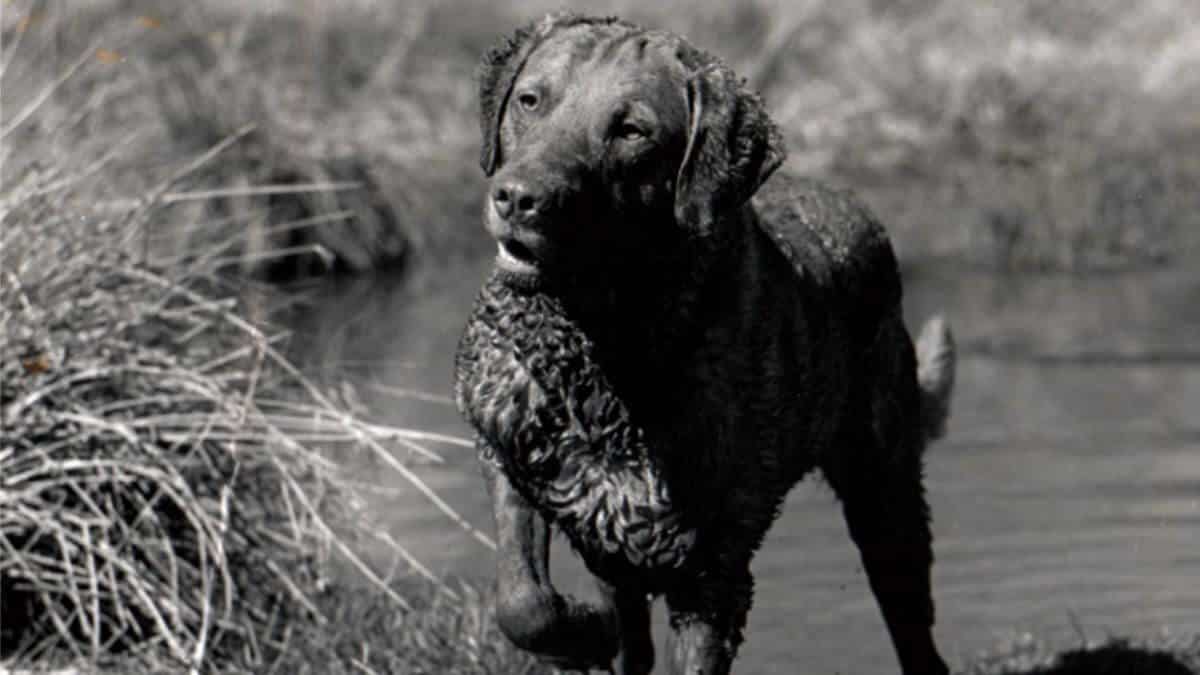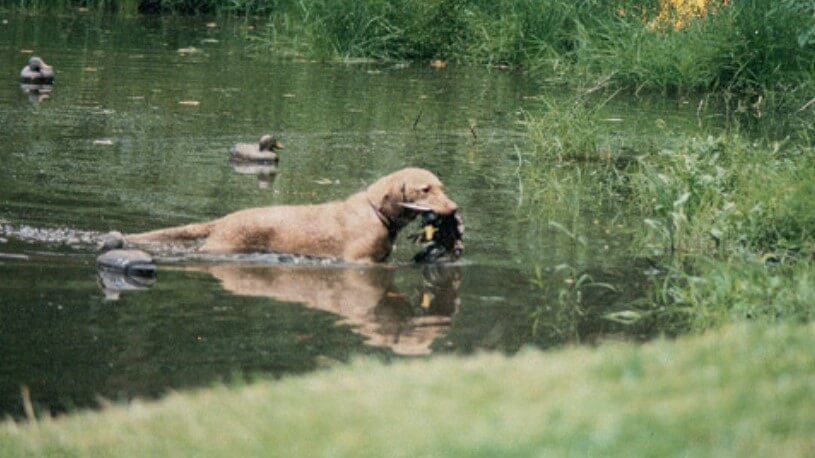


Home » Judging Chesapeake Bay Retrievers

This article was originally published in Showsight Magazine, November 2012 issue.
The art of applying one’s knowledge, standard interpretations and skills to judge is extremely challenging. Look for what a dog’s merits are before you start to get concerned about his faults. This philosophy can prevent you from eliminating a dog from competition because of one or two minor negative flaws as well as from rewarding a dog having nothing outstandingly wrong with him but is basically a dog that in most aspects is mediocre.
There is a section in the book The Dual Purpose Labrador, by Mary Roslin Williams, about type. It is essential to distinguish between breed type and kennel type. There is one breed type in every breed. It is essential that the Chesapeake look like the Chesapeake. If he resembles another breed or looks more like a mongrel, he lacks true breed type. Within breed type there exists “kennel type”. Breeders excel in breeding dogs in different ways and become noted for their “style”. Coats, head type, expression and degree of substance are just a few of the features that can contribute to distinguishable kennel type attributes. When you see a Chesapeake you may say to yourself that looks like one of Mr. X’s specimens.
In comparison to man, the Chesapeake is equivalent to an Olympic swimmer or a marathon runner, not to a heavy wrestler or a weight lifter. Efficient power and agility with good muscle tone is sought for. Cloddy overdone dogs are not to be considered.
I expect a bitch to show femininity. Likewise, the male should be masculine and majestic. If a Chesapeake looks like the opposite sex, this is incorrect and should be faulted to the degree of the deviation. There is more of a tendency for judges to make the mistake of rewarding “doggy” bitches than to reward “bitchy” males. Judges really need to be cognizant of this.
One must consider the whole dog. Getting off track and over-emphasizing one aspect of the dog can lead to poor judging. While judging the Chesapeake, I like to refer to the phrase under symmetry and quality, “The dog should be well proportioned”, then judge all the component parts, relate them to each other and look at the dog as a whole. Throughout the standard, many traits are referred to with a phrase like medium or moderate. I find it most important to keep in mind the verbiage in the standard that places emphasis on strong words: “Shoulders, sloping and should have full liberty of action with plenty of power without any restrictions of movement. … Hindquarters should be especially powerful to supply the driving power for swimming. … Good hindquarters are essential. Stifles should be well angulated. … Flanks well tucked up.”
The Chesapeake must have the ability to swim and retrieve for long periods of time. One can expect a good swimming Chesapeake to be a good moving Chesapeake and vice versa.

Chesapeakes that retrieve objects from the ground or in the water requiring necks and heads well-proportioned with length which combined, permit the nose and mouth to reach the ground or grasp fowl easily in the water. The Chesapeake should not be restricted in the water or forced into a stooped position on the ground.
In examining components of the head, the skull is approximately 5″-6″ wide from root to root of the ears. Overly wide skulls should be avoided. Skull and muzzle are approximately the same length (each is about 4¾”-5″ long). The muzzle is strong and gradually tapers to a pointed look at the tip without being extreme or to give the appearance of a sharp cutting affect. The muzzle should not be blunt, short or snipey. The medium stop implies that the Chesapeake should not be down, dish face or have an abrupt appearance, but rather a clean look. The above describes a head capable of grasping and carrying large game.
The lips should be thin, not pendulous. Thick heavy or fleshy lips, poised without visible support and heavy jowls, all have a tendency to retain feathers – thus, are not desirable. The ears are to be small, approximately 4½”-5″ in length. They are to be set high on a rounded skull, above the eye level but not so high up like a terrier and not high on an undesirable flat skull. Naturally the ears appear a little lower than the skull and the skull appears rounded. When baited and the ears are raised, the appearance is higher. Ear leather should not be too thin or too thick. The ears should hang loosely.
The eyes are medium large and very clear. An oval/oblong eye is implied. Eyes are wide apart in accordance with a 2½”-2¾” width. Wider could cause eyes to project, thus exposing them to brush and brambles and possible injury. A tight lid, open lid, round eyes and/or protruding eyes are undesirable. The color of the eye is specified as yellowish or amber. Amber allows darker shades of yellow that include orange, gold, and light brownish shades of yellow. It is desirable that eye color blends somewhat with the color of the dog to enhance the camouflage desired within the working environment.
The Chesapeake should have a pleasing head that projects a bright and happy disposition and an intelligent expression. Good disposition, a willing to work attitude, and devotion to companion are essential.
Heights are dogs 23″-26″ and bitches 21″-24″. Note that the Chesapeake has a two-inch difference in the ranges. Most sporting breeds have one. Thus there can be a 5″ difference or a 24″ bitch can be one-inch taller than a 23″ male.
The Chesapeake is slightly longer than tall. Slightly implies close to square. Longer and low is not desirable. The topline should be a trifle higher in the rear or same height front and rear. It is typical to have a slight dip near a well laid back shoulder and a short strong back which is well coupled. A sway back is undesirable and contrary to the standard. Pasterns are slightly sloping and good hare feet are required. Hock length is medium. This all facilitates the Chesapeake’s speed and endurance.
Tail is medium heavy at the base and is set well on neither a completely flat or steep croup. Typically the croup is slightly rounded.
Coat is most important to protect the Chesapeake as his function includes an environment that includes cold icy water. The double coat is thick, dense, wavy, harsh outer, wooly under and must be well-covered all over the body. Very short waves may appear curly to someone not completely versed regarding the Chesapeake coat. A kinky appearance is desirable. The curly coat to avoid is the coat of ringlets as seen in the Curly Coated Retriever. Length of coat and where coat is straight and wavy is available in the standard. Coats need to be considered highly, but when judging coat its not either 16 or 0 points. It’s often within the range. When properly judging the whole dog the coat must be considered important, as one considers everything else.
Color includes brown, sedge and deadgrass. All three of these colors allow many colors that include many hues and varying amounts of pigment. Shades of brown are the most commonly seen, but judges should become familiar with all the variety of shades and colors allowed. Note the colors of foliage, fields, and marshes throughout all seasons and in all parts of the country when you get a chance. The variety of colors is that extensive.
There are also Chesapeakes that may show some brindle shades, masking, two colors on the same dog, hound markings and some shades that are grayish referred to as ash. These other colors are a minor deviation from the preference of self colored brown sedge and deadgrass dogs and may be faulted in a minor way. Note that color is only weighted at 4 points. The coat and how color relates to its texture is much more important.
Please review the disqualifications in the standard. When judging you must disqualify any dog that has any of these defects. Temperament is very important. This is a wonderful breed with good attitude and working ability.
